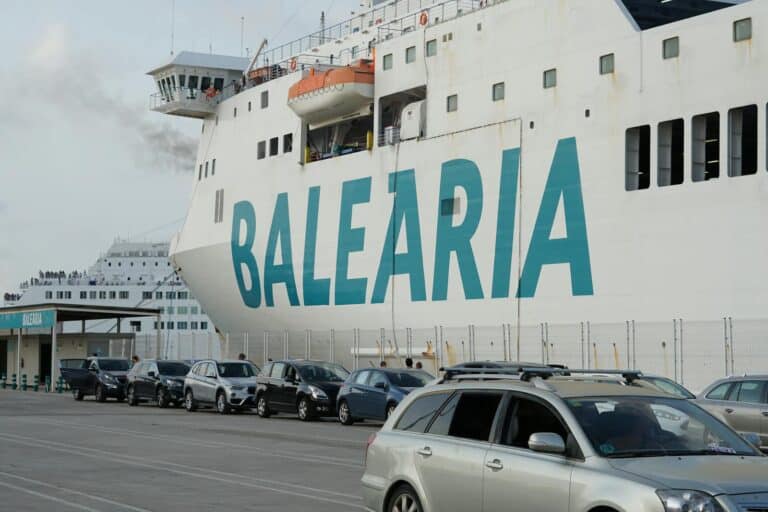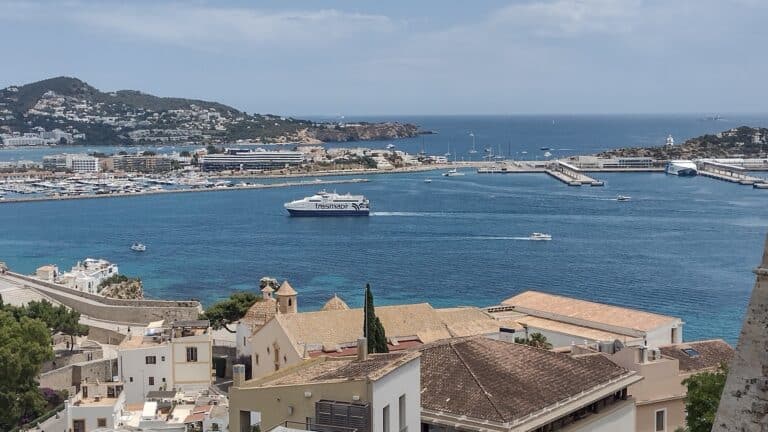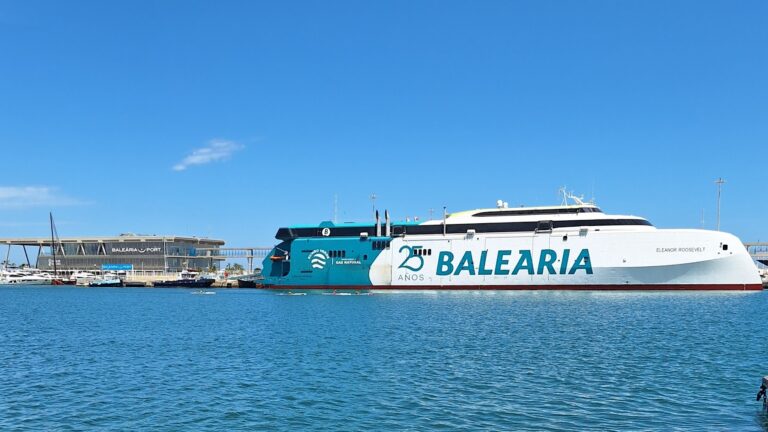Ferry Denia-Ibiza with a car
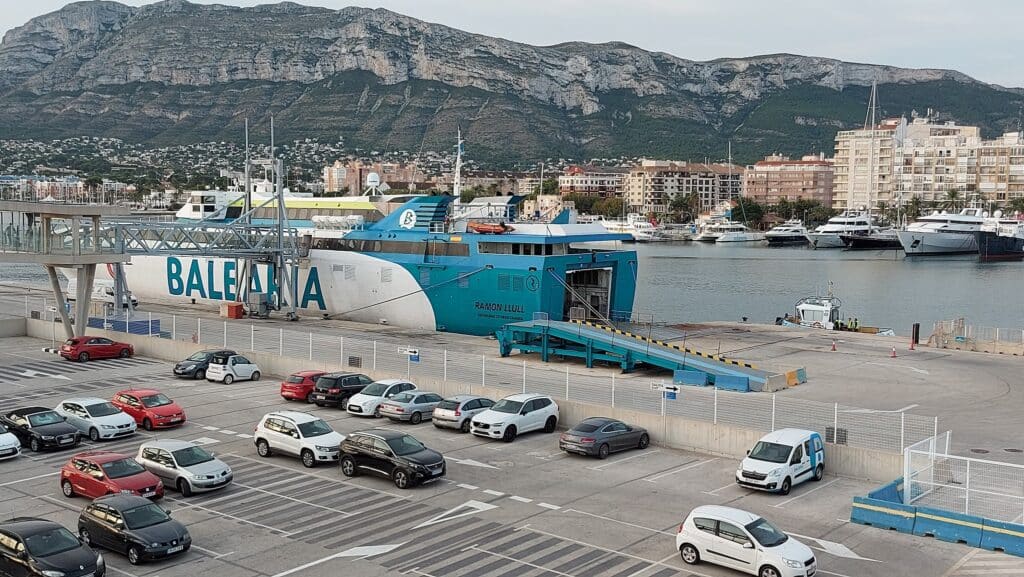
In 2025, I finally decided to fulfill my long-standing dream – to travel to the legendary Ibiza and take my car with me. I never thought before that the ferry service between mainland Spain and the islands could be so convenient and affordable. You board the ferry in Denia with your car and in a few hours you’re already exploring the winding roads of one of the most famous Mediterranean islands.
The distance between the port of Denia and Ibiza is about 90 nautical miles. On modern ferries, this takes from 2.5 to 4 hours depending on the type of vessel and weather conditions.
The ability to take your car on board means no route restrictions, no dependence on public transport or taxis.
In 2025, two main companies operate on the Denia-Ibiza route: Baleària and Trasmediterránea. Each of them offers its own promotions for passengers with cars. The best deals can usually be found by booking early – 2-3 months before the trip.
Denia-Ibiza ferry schedule for 2025 (carriers Balearia and Trasmed GLE)
| Period | Company | Departure | Arrival | Duration |
|---|---|---|---|---|
| January-March | Balearia | 17:00 | 19:15 | 2h 15min |
| April | Balearia | 08:30 | 11:45 | 3h 15min |
| Balearia | 17:00 | 19:15 | 2h 15min | |
| Trasmed GLE | 22:31 | 05:15 | 6h 44min | |
| May-June | Balearia | 08:30 | 10:45 | 2h 15min |
| Balearia | 17:00 | 19:15 | 2h 15min | |
| July-August | Balearia | 08:30 | 10:45 | 2h 15min |
| Balearia | 17:00 | 19:15 | 2h 15min | |
| Balearia | 22:00 | 00:30 | 2h 30min | |
| Trasmed GLE | 22:31 | 05:15 | 6h 44min | |
| September-October | Balearia | 08:30 | 10:45 | 2h 15min |
| Balearia | 17:00 | 19:15 | 2h 15min | |
| November-December | Balearia | 17:00 | 19:15 | 2h 15min |
Notes on the schedule:
- Trasmed GLE:
- Voyages are operated on the Ciudad de Mahón vessel with a stop in Formentera.
- 3-4 trips per week available (April-August), daily in July-August.
- Duration of Balearia voyages:
- Increased travel time in April is due to a technical stop.
- Night voyage (22:00) in July-August offers cabin services.
- Seasonal changes:
- Trasmed GLE does not operate from January to March.
- Balearia morning voyages are available from April to October.
Price dynamics (starting rates):
| Company | Passenger ticket | Car |
|---|---|---|
| Balearia | 40–85€ | +35–80€ |
| Trasmed GLE | 55–110€ | +50–100€ |
For current schedules and bookings, use:
🔗 Balearia Official Website
🔗 Trasmed GLE Portal
Baleària, for example, has launched a new “Eco-Car” program that offers a 15% discount to owners of hybrid and electric vehicles. According to their official website, more than 5000 travelers have taken advantage of this discount since January 2025.
The cost of ferry crossing with a car ranges from 90 to 250 euros one way. The price varies depending on the season, day of the week, and even time of day. January-February and November are the most budget-friendly months for such a trip. Discounts on ferry Denia Ibiza con coche can reach up to 40% off peak summer prices.
My personal experience has shown: night voyages are 10-15% cheaper than daytime ones, and Tuesday and Wednesday are usually the least expensive days for departure.
And yes, buy round-trip tickets at once – you’ll save about 20%.
I’ve accumulated a few useful tricks during preparation and the trip itself. First, register for loyalty programs of all ferry companies in advance. Even if you don’t know which one you’ll choose yet. Bonus points and status often give priority boarding rights.
Second, check your fuel level before loading. On Ibiza, gas is 10-15 cents more expensive than on the mainland. For my tank, that’s a difference of about 7-8 euros – not critical, but a nice bonus to the budget. Gas stations in Denia port work 24/7. Convenient.
Don’t fall for the basic rates that shine so nicely on banners. The real price often includes mandatory fees and surcharges. Special offers for ferry tickets with cars are divided into three categories: seasonal sales (the deepest discounts up to 45%), flash deals (short-term but with good conditions – usually 20-30% discounts) and package offers (ferry + hotel on the island – about 15% savings compared to separate bookings).
Among the additional services, it’s worth paying attention to the option of booking seats in the lounge area – from 15 euros per person. On night sailings, it’s definitely worth the money.
Arrive at the port early – at least 90 minutes before departure. The car check-in procedure takes time, especially during high season. I arrived two hours early and didn’t regret it – I had time to calmly have a coffee and even take a short walk along the Denia promenade.
Documents are checked thoroughly. Besides passport and ticket, you need a driver’s license and car documents. Rentals require additional papers from the rental company – be sure to clarify this in advance.
Speaking of rentals: many rental agencies on the mainland allow taking cars to Ibiza with prior agreement. The surcharge is about 50-80 euros, but it’s cheaper than renting a car directly on the island.
Modern ferries on the Denia-Ibiza route are mini cruise liners with bars, restaurants, and shops. Some vessels even have swimming pools and cinemas. Four hours fly by unnoticed.
Ferry companies and schedules for Denia – Ibiza
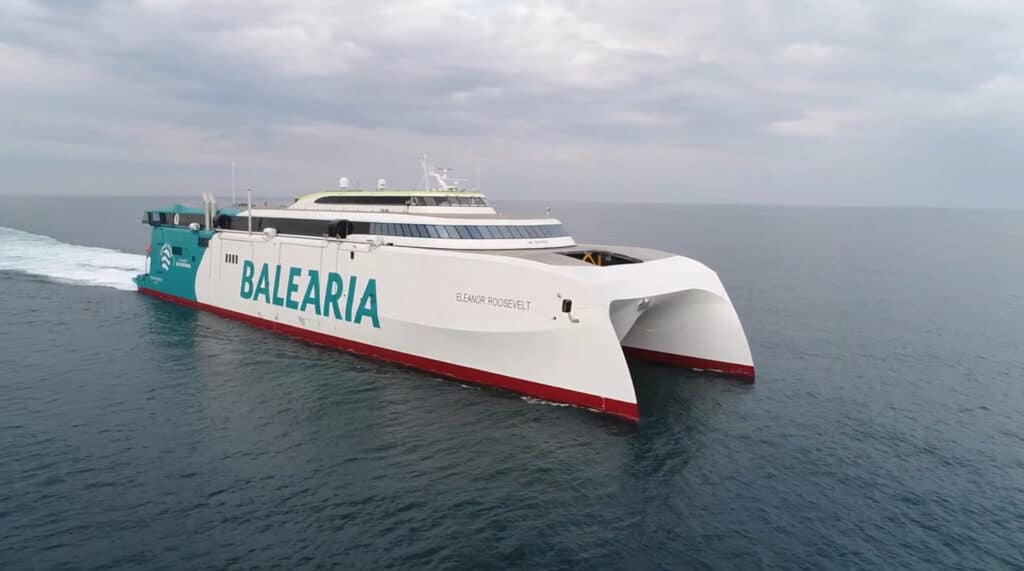
But there’s a catch – on most ferries, cellular service only works within 20-30 minutes of the shore. Then comes a blissful information silence. I recommend downloading a book or movie in advance. I prepared a documentary about Ibiza itself – an excellent introduction to the local culture.
On my ferry, there was even a small lecture hall with hour-long talks about the history of the Balearic Islands. Such entertainment for intellectuals in the middle of the sea.
The main player on the Denia-Ibiza route in 2025 remains the company Baleària. Their flagship – the high-speed ferry Eleanor Roosevelt – is the world’s first passenger vessel with a liquefied natural gas engine, capable of reaching speeds up to 40 knots. On board this sea cheetah, you arrive in Ibiza just 2 hours and 15 minutes after leaving Denia.
Besides the eco-friendly giant Eleanor, the company operates several smaller vessels – a series of fast ferries with telling names like Poeta, Bahama Mama, and Posidonia. These catamarans are slightly slower than the flagship but still deliver you to the island in 3-3.5 hours.
In addition to Baleària, you can use the services of Trasmediterránea. Their ferries are slightly slower (the crossing takes 3.5-4 hours), but they often offer more humane prices during high season, especially for larger vehicles.
For bargain hunters, I recommend checking out Clickferry – it’s an aggregator that collects offers from all ferry companies. From my observations, sometimes you can find tickets 5-7% cheaper there than when booking directly.
My experience has shown that the difference between companies is not as significant as it may seem.
In 2025, the ferry schedule for the Denia to Ibiza car ferry route became even more convenient. During peak season (May-September), 4-5 departures run daily, with the first at 7:30 AM and the last at 10:45 PM. The shoulder season (March-April, October) offers 2-3 daily trips. In winter, frequency drops to 1-2 departures, mostly during daytime hours.
My trip was in early May. I chose the 3:30 PM departure – perfect timing. I had time for a leisurely breakfast in Denia, check my car, and complete all paperwork without rushing. I arrived in Ibiza around 6:45 PM – just in time to check into the hotel and enjoy an evening stroll.
Baleària regularly updates its schedule on balearia.com with an option to filter specifically for the Denia-Ibiza car ferry route. Trasmediterránea does the same on trasmed.com.
Aggregators like Clickferry (clickferry.com) also show up-to-date information, but with a slight 1-2 day delay for updates.
On all these websites, you can specify that you’re planning a trip with a car and immediately see the corresponding prices.
In July-August 2025, Baleària launched additional night ferries on Fridays and Saturdays. These “party ferries” (as dubbed by the press) depart from Denia at 11:59 PM and arrive in Ibiza at 3:30 AM. Sounds odd, but it’s perfect for young people eager to hit the clubs at the crack of dawn.
January sailings are often adjusted depending on weather conditions. According to Denia port statistics, about 15% of winter crossings are postponed or canceled due to storms.
Check the schedule 48 hours before departure. Companies may make changes, especially during the off-season.
Ticket prices and deals: how to save on the Denia – Ibiza ferry
When it comes to money on vacation, it’s always the same story – there’s never enough to spare. The first thing I was interested in when planning my trip was how much this sea voyage with a car would cost. In 2025, the pricing policy of ferry companies on the Denia to Ibiza car ferry route became more flexible than before. The price range for passengers starts from €60 in basic class and goes up to €79 and above in premium. Add to this the cost of transporting a car – and you’ll get a sum worth thinking about.
Car transport is a separate expense. My mid-size sedan cost about €110 one way. For a motorcycle, you’ll pay just €14.50 – almost eight times less! Large vehicles like SUVs start from €116. A roof rack can also increase the cost.
When it comes to saving money, you start looking for all possible loopholes. Booking 2-3 months in advance gives a discount of up to 25% – a fact I’ve personally verified. I managed to save €85 on round-trip tickets. According to Baleària’s website, early bookings in January 2025 resulted in 18% more cars transported compared to the same period in 2024 – people have clearly learned how to save.
Bargain hunting has become a kind of sport for me. The first source is the official carrier websites. Baleària regularly launches seasonal sales, especially at the beginning and end of the tourist season. I remember sitting with three browser tabs open, comparing prices on Baleària, Ferryhopper and Clickferry. I spent an hour and a half on it, but saved €43 – a decent dinner with wine in Ibiza, by the way.
Ferryhopper sometimes offers exclusive discounts that aren’t available on official websites. Their search system allows you to compare all options by date. Clickferry, for its part, often runs flash sales with discounts up to 30%, but you need to read the terms carefully – sometimes they only apply to certain service classes.
I discovered an unexpected source of discounts – local tourist offices in Denia. They offer combined ferry+hotel tickets with a discount of about 10-15%. For my week-long trip, this resulted in savings of €120 for two people. However, the benefit depends on the chosen hotel – use a calculator to help you.
In 2025, Baleària introduced a special fare structure for different groups of travelers. For example, families with children under 12 get a 15% discount when booking a full package (passengers + car). With a ferry cost of around €350 for a family of four with a car, the savings amount to over €50.
For pensioners, there’s a “Special Senior Rate” – a 12% discount upon presentation of relevant documents. A retired colleague with whom I was planning a trip was pleasantly surprised when the system automatically applied the discount after entering the date of birth. In our time, you rarely enjoy your own age, but this was one of those cases.
Young people aren’t left out either. Students with ISIC student cards are entitled to a 10% discount.
The most advantageous option for groups of 4 or more people is the group rate with savings of up to 20%. According to Trasmediterránea, in the summer season of 2025, more than 30% of all passengers with cars used this option.
The price range between high and low seasons is striking. In July-August, transporting a car will cost about 40-45% more than in February-March. My cabin neighbor on the return trip – a local businessman – told me that he always plans his trips to the mainland on Tuesday or Wednesday of the first half of the month. According to him, these are the cheapest days and periods.
His theory was confirmed when I compared prices on the company’s website – the difference between Monday and Tuesday was €15 for a standard ticket with a car.
Data from the port of Ibiza for the first quarter of 2025 shows that the average ferry occupancy on weekdays is about 65%, rising to 85-90% on weekends. Logically, prices follow demand.
Booking ferry tickets from Denia to Ibiza: step-by-step guide
The few hours I spent studying all the nuances of booking ferry tickets between Denia and Ibiza saved me about €120. The main discovery – the ferry Denia Ibiza con coche booking system works on the principle of airline tickets: the closer the departure date, the higher the price. Therefore, as soon as I decided on the travel dates, I sat down at the computer with a cup of strong coffee and opened three browser tabs at once. Operation “Booking” began.
Online ticket booking eliminates the need to stand in queues at the port or travel agency. Saving at least an hour of time is not bad.
My first booking attempt in 2023 ended in failure – I didn’t account for the car dimensions and ended up paying extra on the spot. In 2025, I approached the matter thoroughly.
The Baleària website (balearia.com) greeted me with a friendly interface and a Russian version – pleasantly surprised. The booking process turned out to be intuitive even for someone whose relationship with computers can be called tense. On the main page, you need to select the “Denia-Ibiza” route, specify the dates, and immediately check the “with car” box. The system will ask you to enter the registration number, car make, and dimensions. Be careful here – an error of a couple of centimeters can change the tariff category.
On the next screen, you choose a specific voyage – pay attention to the type of vessel. Fast ferries cost more but save time.
I was surprised when the system offered to choose a specific place for the car on the ferry – just like in a cinema! The lower deck is further from the exit, but the car is less exposed to salt spray there. The upper deck is more convenient for loading/unloading.
Clickferry and Ferryhopper are two main ferry ticket aggregators working with Spanish routes. Their advantage is the ability to compare prices of different carriers with one click. I didn’t immediately notice the disadvantage – a service fee of about €8-12 per transaction. A small amount, but it left a bitter taste.
The booking process is similar to official websites, but I found the Ferryhopper interface more user-friendly. There’s a feature to compare prices by date – you can shift your trip by a day or two and save up to €40.
I chose Ferryhopper when I discovered a promo code for a 7% discount for new users. Greed overcame principles.
By the way, aggregators often run promotions. I subscribed to newsletters from both sites.
Before booking, it’s worth gathering all necessary documents in one place. For successful ferry ticket booking with a car, you’ll need: passport details of all passengers, driver’s license, vehicle registration certificate (VIN number and registration plate required), car dimension data (length, width, height).
For a rental car, you need authorization from the rental company to cross the sea border. Many people forget about this.
Triple-check the accuracy of the entered data. A typo in the vehicle number will result in additional paperwork hassle at the port.
Payment on carrier websites and aggregators is accepted by bank cards of all major payment systems. In 2025, Baleària added the option to pay via PayPal and Apple Pay – convenient for iPhone owners. Clickferry currently only accepts cards but works with most banks.
When paying for the ticket, pay attention to the currency of the charge. Some sites offer a choice between euros and dollars. My bank charges 1.5% for conversion, so I always choose to pay in euros.
Interesting point: when paying the full fare, rather than a promo price, free cancellation insurance is often provided.
After successful payment, an electronic ticket in PDF format is sent to the specified email. It contains a QR code that will need to be shown when boarding. In 2025, Trasmediterránea launched a mobile app with electronic tickets, but it’s still working unstably. Upon receiving the ticket, I recommend saving the PDF on your phone in a special folder. Print the ticket – a paper copy will never let you down. Forward a copy to your backup email – you never know what might happen to your main one.
A paper copy saved me when my phone died right before boarding. Now I always bring a printed version with me, despite my wife’s teasing.
Traveling with a car on the Denia – Ibiza ferry: what you need to know
Changing and canceling reservations
Even the most well-thought-out plans sometimes need to be changed. Fortunately, in 2025, ferry companies have become more flexible on this issue. According to Baleària’s rules, changing the date of a ticket with a car is possible without penalty 72 hours before departure. Within 48-72 hours, a fee of €15 per person is charged. Closer to departure – 25% of the ticket price.
I had to push my return date back by one day due to a sudden meeting with an old friend in Ibiza. I did this 4 days before the trip – it came without a penalty.
A full refund is possible when canceling 7+ days in advance. Within a week, the company retains 10% to 50% of the cost depending on the timeframe.
Interesting fact: over 35% of bookings on the Denia Ibiza ferry with car line are subject to changes. People tend to adjust their plans, especially for longer vacations.
Check the technical condition of the car
When you step onto a ferry with your own car, there’s a special sense of freedom. But this freedom requires preparation. Two days before departure, I thoroughly checked the technical condition of the car – the last thing you need on an island with limited auto repair shops is a breakdown. Check the oil level, brake fluid, tire pressure, and air conditioning – in Ibiza in 2025, the average summer temperature stays around 30°C.
Gather documents for the ferry crossing
I collected all documents for the ferry crossing in a separate folder – I put my passport, driver’s license, vehicle registration certificate, insurance, and printed tickets in it. This methodical approach saved me from unnecessary stress during boarding.
Arrive at the port early
I arrived at the port of Denia two hours before departure. Excessive? Maybe. But it’s better to have an extra cup of coffee at a port cafe than to stress out in traffic on the way to the loading area.
What to do and bring with you
A ferry trip lasting 2-4 hours doesn’t require special preparations, but some items will make the journey more comfortable. In my essentials bag, I packed: basic medicines (for motion sickness, painkillers), a bottle of water, a phone charger, headphones, and a pre-downloaded movie. I took seasickness pills even though I have a strong stomach – the sea is unpredictable.
For the car, I needed: cleaning supplies for salt spray on windows and headlights, towels for wiping seats (in case the ferry deck is damp), and a basic tool kit. Extraordinary? Perhaps. But once I found myself with foggy windows and no way to clean them.
I downloaded offline navigation maps of Ibiza while still in Denia – mobile internet on the island works great in 2025, but I wanted to spend the first few hours without searching for a local SIM card.
Choosing a car
Upon arriving in Ibiza with my own car, I immediately noticed the peculiarities of local roads. The main difference is the narrow winding roads in mountainous areas. Useful tip: choose a more compact car if you plan to explore the island’s interior. My mid-size sedan sometimes struggled to squeeze through village streets.
Some beaches have dirt roads leading to them. If your car isn’t prepared for light off-roading, check the route in advance. I nervously sweated a couple of times when the asphalt suddenly ended, and the navigator calmly demanded to continue driving.
Parking
During high season, finding a free parking spot becomes a quest with multiple difficulty levels. Paid parking costs from €1.5 to €3 per hour depending on the area’s popularity. In remote bays like Cala Comte or Cala Saladeta, parking costs €5-10 per day, but spaces are usually available even at peak season.
Fuel
Fuel on Ibiza costs 10-15 cents more than on the mainland. In 2025, the average price of a liter of AI-95 gasoline was €1.85 compared to €1.70 in Denia. The difference isn’t critical, but for a full tank, the savings amount to about €7-9. Diesel is traditionally cheaper – about €1.60 per liter.
Gas stations on the island are unevenly distributed – mainly near large settlements. There are few of them in the island’s interior. The most accessible networks are Repsol and Cepsa, which accept all major bank cards.
Some gas stations offer self-service with a discount of 2-3 cents per liter. Instructions in English are usually available.
Port of Denia: how to get there, parking, infrastructure

The famous port of Denia welcomes travelers with updated infrastructure in 2025. It’s located at Estación Marítima de Dénia, Baleària Port – these are the coordinates I entered into my navigator, preparing for my ferry Denia Ibiza con coche adventure. My first tactical move was to scout the route to the terminal. It turned out that the Spanish have designed the navigation to the port quite thoughtfully, with signs on the main approaches to the city.
There are several ways to reach the port. If you flew into Alicante or Valencia airports, local buses will take you to Denia for a reasonable price. From the city center, the Denibús line L3 runs every 30 minutes and stops right at the maritime terminal. The fare in 2025 is €1.85. Convenient and budget-friendly.
A taxi will work faster but hits the wallet harder.
In my own car, I took the AP-7 highway and followed the signs to Denia. GPS tried several times to direct me along a “shortcut” through some villages, but I decided not to experiment. Classic road wisdom – main routes are more reliable than local shortcuts, especially when a ferry is waiting ahead.
A headache for many travelers – where to leave the car if you decided not to take it to Ibiza. In 2025, the port of Denia offers two main parking areas: short-term P1 (up to 4 hours) and long-term P2. I chose the latter for my week-long trip. Rates are about €12 per day, and a weekly pass will cost around €72. Compared to airports – the price is heavenly.
You can book a parking spot online through the official port website – balearia.com. I did this three days before the trip and got a 10% discount. I even had the sense to photograph my parking spot number so I wouldn’t wander between rows of cars upon return.
P2 has electric charging stations for eco-friendly cars – a great bonus for owners of modern vehicles.
If you can’t afford the official parking, there are private lots within a kilometer of the port with rates from €8 per day. The savings are substantial, but you’ll have to walk with your luggage or use their paid transfer service (about €3).
The Denia maritime terminal, after the 2024 reconstruction, looks like a miniature airport – bright, spacious, and functional. The waiting area is equipped with comfortable seats and free Wi-Fi, which, unlike many other “free” networks, actually works at a decent speed. I managed to download two movies to my tablet while waiting for boarding.
The gastronomic part of the port pleasantly surprised me. Cafe “El Timón” offers excellent sandwiches and freshly squeezed juices, while restaurant “Marina” will delight you with a full seafood lunch. Prices are about 15% higher than the city average, but this is standard for transport hubs.
Shops in the terminal are represented by a souvenir store, a miniature supermarket, and a pharmacy point. I bought sunscreen there, which I unexpectedly forgot at home – paid €3 more than the same tube would cost in a city pharmacy.
Parents with children will like the small play area with slides and soft modules. The serene faces of parents spoke for themselves – the idea of a playground in the port was definitely a success.
In 2025, Baleària continues to delight passengers with the free La Panseta transfer. This small electric shuttle runs between the center of Denia and the sea terminal every 45 minutes from 7:30 to 21:00. You can book it through the company’s mobile app 24 hours before arriving at the port.
I tested this service when I arrived by bus from Alicante. The bus dropped me off at Denia’s central station, from where La Panseta smoothly delivered me to the terminal itself. The electric mini-bus moved almost silently, the driver was friendly and even helped with loading the suitcase.
However, I’ll note that during peak hours, there are more people wanting to use the free transfer than seats available, so reserve your spots in advance.
Arrival in Ibiza: port, transport, first steps
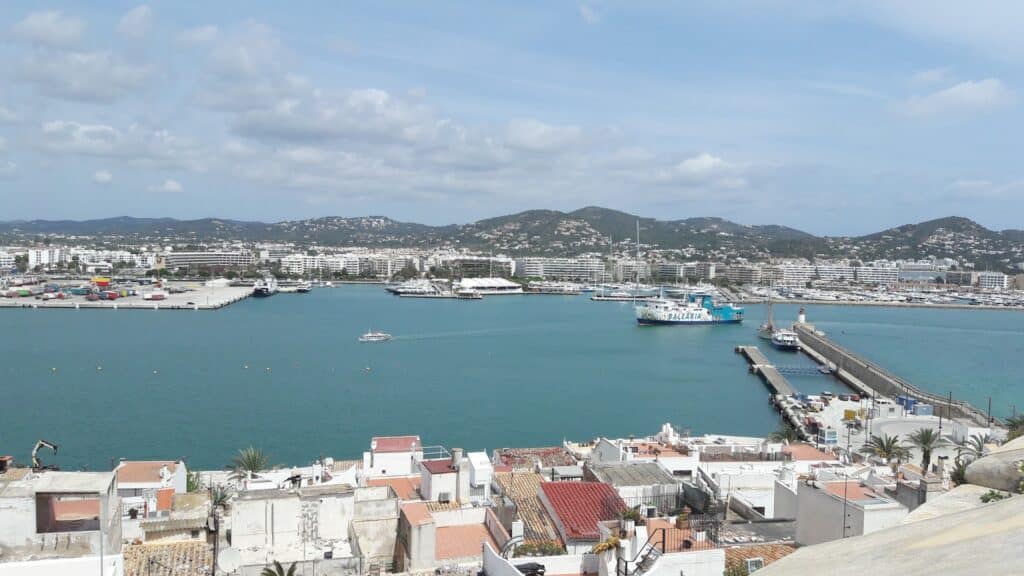
Stepping off the ferry onto Ibiza’s soil, I felt like a captain completing an important sea mission. Ibiza’s port greeted me with bright sunlight and the smell of salt. After traveling the ferry Denia Ibiza con coche route, my first impression was surprisingly organized – no chaotic bustle, clear signage, and understandable navigation. It’s one thing to read enthusiastic reviews, and quite another to steer your own car off the ferry deck onto Spanish soil, where a week of freedom, music, and Mediterranean gastronomy awaits you. In 2025, the port of Ibiza has transformed into a modern complex with well-thought-out logistics for passengers with cars.
The port itself is located in the southeastern part of the island, literally a couple of kilometers from the historic center of Ibiza town (Eivissa). After disembarking from the ferry, car drivers follow a specially designated lane that smoothly integrates into the city’s road network.
At night, the port looks particularly impressive – the lighting gives it a futuristic appearance.
The port’s infrastructure has noticeably improved in recent years. New terminals, cafes, shops, and even a small information center for tourists have appeared here. I remember my first visit to the island in 2019 – then the port resembled more of an abandoned industrial zone with minimal amenities. Now it’s a well-maintained modern space where even the most discerning traveler feels comfortable.
Having arrived in Ibiza with my own car via the ferry Denia Ibiza con coche route, I found myself in an advantageous position – no worries about transportation. However, for those arriving on the island without personal transport, there are several options for getting around.
Bus line L10 connects Ibiza port with the city center and airport, with tickets costing about €3.50 in 2025. The schedule can be checked on ibizabus.com – buses run every 30 minutes during high season and hourly in the off-season. Comfortable air-conditioned buses with Wi-Fi are a nice bonus for tired travelers.
Taxis line up neatly right at the terminal exit. A ride to the city center costs about €10-15, to San Antonio – €25-30. Travel time to the center is only 5-7 minutes, to San Antonio – about 20 minutes. All taxis are equipped with meters, but it’s better to clarify the approximate cost with the driver before the trip.
Hotel transfers are another option worth considering. Many hotels offer this service for free or for a nominal fee. Just inform them of your arrival time in advance, and they’ll meet you with a sign.
You can rent a car right at the port – in 2025, five rental companies operate here: Avis, Europcar, Hertz, Sixt, and the local Motorent. Prices start from €35 per day for a compact car in low season and can exceed €100 during peak August weeks. Booking a car online usually turns out 15-25% cheaper than on-site. I checked this with my own wallet.
After disembarking from the ferry, the first thing I did was update my phone plan. There’s a Vodafone kiosk at Ibiza port where I bought a SIM card for €20 with 40 GB of internet and calls within Spain for 30 days. Alternative operators Orange and Movistar offer similar conditions. Only a passport was needed to get the SIM card. The seller quickly activated the number, and literally within five minutes my phone was ready to work on Spanish frequencies.
I don’t recommend using currency exchange offices in the port – the rate there is unfavorable, with a commission of about 5-7%. It’s better to withdraw euros from ATMs right in the terminal building – Santander or CaixaBank offer fairer conditions.
Be sure to keep your ferry tickets – sometimes they entitle you to discounts in shops and restaurants on the island.
The tourist information kiosk in the port is open from 9:00 to 21:00 daily. You can get a free island map, bus schedule, and brochures with basic information there. The girl at the counter spoke five languages, including Russian – a nice addition to the service.
After disembarking from the ferry Denia Ibiza con coche, it was time to decide where to head next. Ibiza is compact – the island is only 41 km long and 15 km wide, but each area has its own character and atmosphere.
The city of Ibiza (Eivissa) is the capital and administrative center of the island. The old town with its 16th-century fortified walls is a UNESCO World Heritage site. Narrow streets, white houses, boutiques, restaurants, and the famous marina with luxurious yachts are its calling card. This area concentrates many historical landmarks and premium nightclubs.
Things to do in Ibiza: best beaches and activities for independent travelers
The sense of freedom that your own car gives you on the island is priceless. After a comfortable journey on the Denia to Ibiza ferry route with a car, I found myself in the position of a privileged explorer. No time constraints, no overcrowded buses, and no taxis with astronomical fares. Just me, the steering wheel, and the endless possibilities of this Mediterranean paradise. In 2025, the island’s infrastructure became even more car-friendly – updated roads, convenient parking, and numerous signs in English.
A car in Ibiza is the key to the island’s treasures. I was able to visit those secluded coves and beaches that are impossible to reach by public transport. In the evening, I parked right by the clubs without worrying about the last bus. However, when planning nighttime activities, I always kept the taxi option in mind – alcohol and driving don’t mix, even on vacation.
Renting a car on the island is at least 30% more expensive.
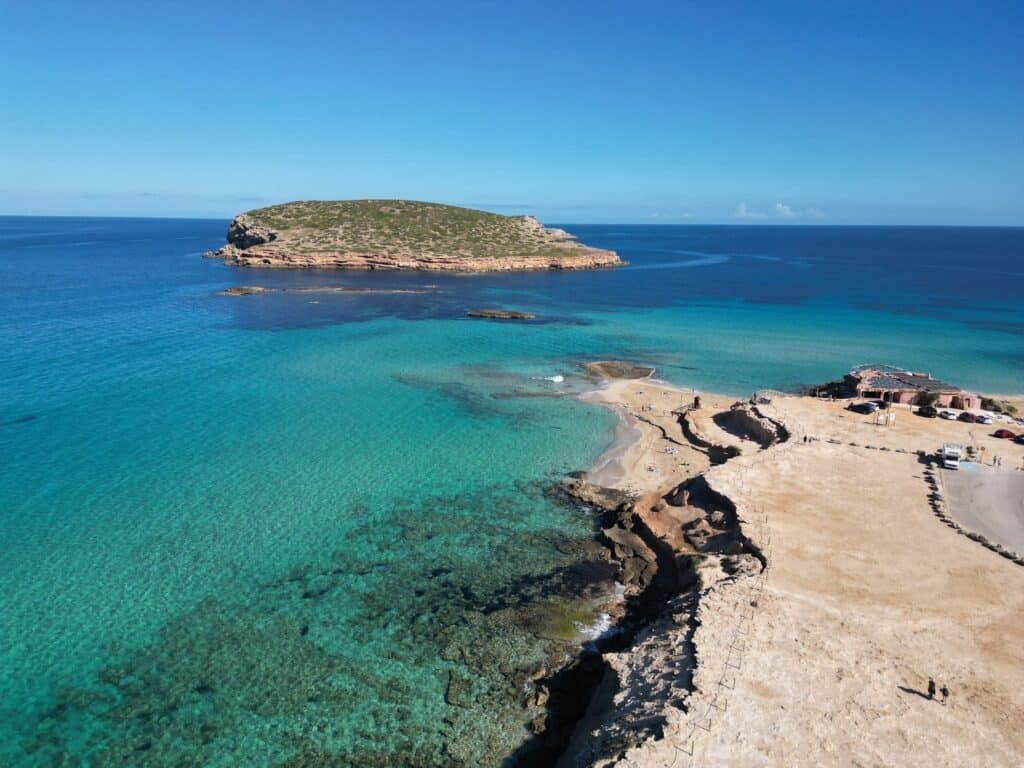
Cala Conta captivated me at first sight. Turquoise water, white sand, and a stunning sunset that even locals flock to see. The parking lot is spacious but fills up by noon. I arrived at 10 am – the perfect time for comfortable placement. The Sunset Ashram restaurant on the cliff offers amazing cocktails and Mediterranean dishes. Prices are steep (a seafood platter cost me €45), but the view is worth every euro spent.
Cala Bassa is another jewel in the island’s crown. The water is so clear you can see small fish at a depth of three meters. Parking is paid (€5 per day in 2025) but spacious. A convenient path through a pine forest leads to the beach, providing welcome shade on hot days. Cala Bassa Beach Club (CBbC) offers sunbeds for €18 per day – not cheap, but the service quality is impeccable.
I fell in love with Cala Salada completely and irrevocably. This cozy bay is surrounded by pines, creating a natural protection from the heat. It’s practically impossible to get here by public transport, so it’s always calmer than on popular beaches. The parking lot is small, only for 40-50 cars. During high season, arrive before 11 am or use the online booking system (introduced in 2024). I love snorkeling. The underwater world here is rich and diverse.
Cala Jondal is a beach for those who value comfort and don’t mind paying for it. This is where wealthy tourists and local elites gather. The famous Blue Marlin restaurant is a place where you can spot celebrities and admire luxurious yachts. I paid €25 for a cocktail, but the atmosphere was worth it. Parking is free and quite spacious. Getting here without a car is painfully long, with transfers and waiting.
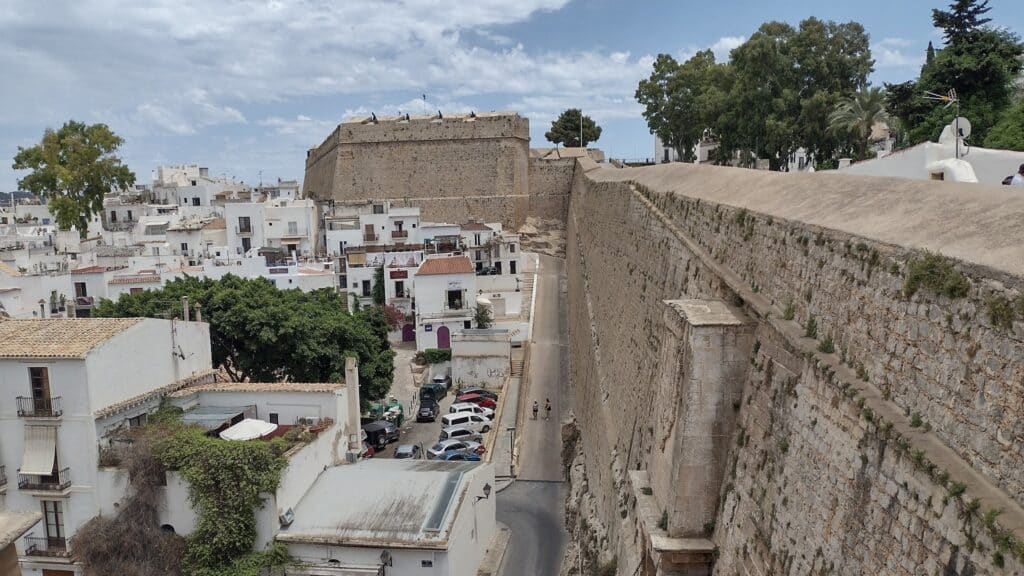
Dalt Vila is the old town of Ibiza, included in the UNESCO list. A labyrinth of narrow streets, 16th-century fortification walls, and breathtaking views from the bastions. Parking near the fortress is paid (about €2 per hour), but there’s free municipal parking a 15-minute walk away. I left my car there, and the stroll through the modern city became an excellent introduction to the historic part. Visiting the modern art museum in former military barracks thrilled me – the exhibition changes every three months.
Can Marçà Caves in the north of the island are a natural wonder, easily accessible only by car. The winding road to the caves passes through picturesque hills with stunning sea views. The parking lot is small, literally for 20-25 cars, but most tourists spend no more than an hour here. The tour costs €15 per person and lasts about 40 minutes. Inside the caves, there’s an amazing underground waterfall and a light show highlighting the beauty of stalactites and stalagmites.
The village of Santa Gertrudis de Fruitera in the center of the island. White houses, cozy cafes, and bucolic landscapes around. Bar Costa restaurant with its famous ham sandwiches became my favorite – simple food, but what a taste! The owner told me that in the 70s, hippies and local artists gathered here, paying for food with their works. Many of these paintings still hang on the walls. Parking in the village is free, but it’s difficult to find a spot during lunchtime. I recommend arriving at 11 am or after 4 pm.
Tips and hacks for a comfortable ferry journey from Denia to Ibiza
When I first thought about traveling to Ibiza by ferry from Denia with a car, I had a lot of questions about the practical side. A ferry isn’t a plane; it has its own rules. In 2025, much has changed in the organization of this route, and my experience of crossing with a car was so pleasant that I decided to share the information. Long hours of studying forums and consulting with locals have now turned into a set of proven recommendations for those who dare to embark on such an adventure.
Documents are the foundation of a stress-free journey. I double-checked the presence of my passport, printed tickets, and car documents. In 2025, most carriers on the Denia to Ibiza ferry route with a car accept electronic tickets, but in my case, the internet suddenly disappeared right before boarding. The paper copy saved the situation.
I divided the money into three parts: cash euros, main card, and a backup card from another bank. This approach saved me from trouble when the terminal on board suddenly refused to accept cards from a certain bank.
I never forget to bring a light jacket or sweater with me.
Clothing should be comfortable and layered. The air conditioning on ferries works at full power, creating an almost Arctic climate inside. At the same time, the upper deck greets you with Mediterranean heat. A T-shirt, shirt, and light windbreaker solved this problem for me. A cap protected my head from the sun, and sunglasses came in handy not only on the deck but also in the car when disembarking – the sun in Ibiza is particularly bright.
Sunscreen with SPF 50 turned out to be my salvation. Half an hour on the open deck was enough for my nose to acquire a tomato shade. Moisturizing wipes helped get rid of the salty feeling on the skin after the sea breeze.
A small thing that many overlook – a reusable water bottle. There are drinking fountains on board, and there’s no point in overpaying for bottled water in the café.
The Mediterranean Sea is usually calm, but even slight rocking can spoil the trip. Choosing a seat on the ferry is the first step to a comfortable voyage. The central part of the ship experiences minimal rocking. I sat away from the engines (to avoid the smell of fuel) and closer to the center of the ship. The difference was enormous – my neighbors seated at the stern complained of discomfort.
Motion sickness medication should be taken 30-40 minutes before departure. Dramamine is my personal savior. This tried-and-true pill works gently and doesn’t cause drowsiness, unlike some alternatives. Vestibular patches behind the ear also work well, but they need to be applied 3-4 hours before the trip. Focusing your gaze on the horizon helps maintain balance.
Food affects how you feel. Heavy, fatty food before boarding is a sure way to nausea. Two hours before departure, I had a light breakfast: avocado toast and green tea. No alcohol! A fellow traveler who had a couple of glasses of wine before boarding spent the entire journey hugging the toilet bowl. Ginger candies or tea are great for relieving mild discomfort during the trip.
Distraction is a proven method. An engaging book or movie helps focus on the plot rather than the ship’s rocking. Noise-canceling headphones isolate you from external sounds, creating a personal space even in a crowded cabin.
The first thing many travelers wonder about is whether they can bring their own food on the ferry. On the ferry Denia Ibiza con coche route in 2025, there’s a liberal policy: snacks and non-alcoholic beverages are allowed. I brought sandwiches, fruits, and nuts – a smart move. Prices in the onboard café turned out to be about 30 percent higher than onshore. Alcoholic beverages are not allowed – they’ll be confiscated during the security check.
The restaurants and cafes on the ferries offer a diverse menu. The self-service cafeteria surprised me with quite decent portions of paella (€12) and fresh seafood. Prices are above average, but not astronomical. The à la carte restaurant on the upper deck is an option for those willing to splurge for the view. Lunch for two will cost at least €50-60, but the panoramic windows offer stunning sea views.
An unexpected discovery was the fresh bar with excellent smoothies (about €6 for a large glass) and freshly squeezed juices. After a hearty meal, I felt sleepy, so I recommend light snacks and saving the main meal for when you arrive in Ibiza.

